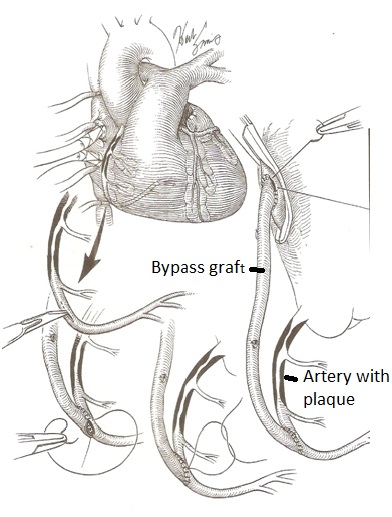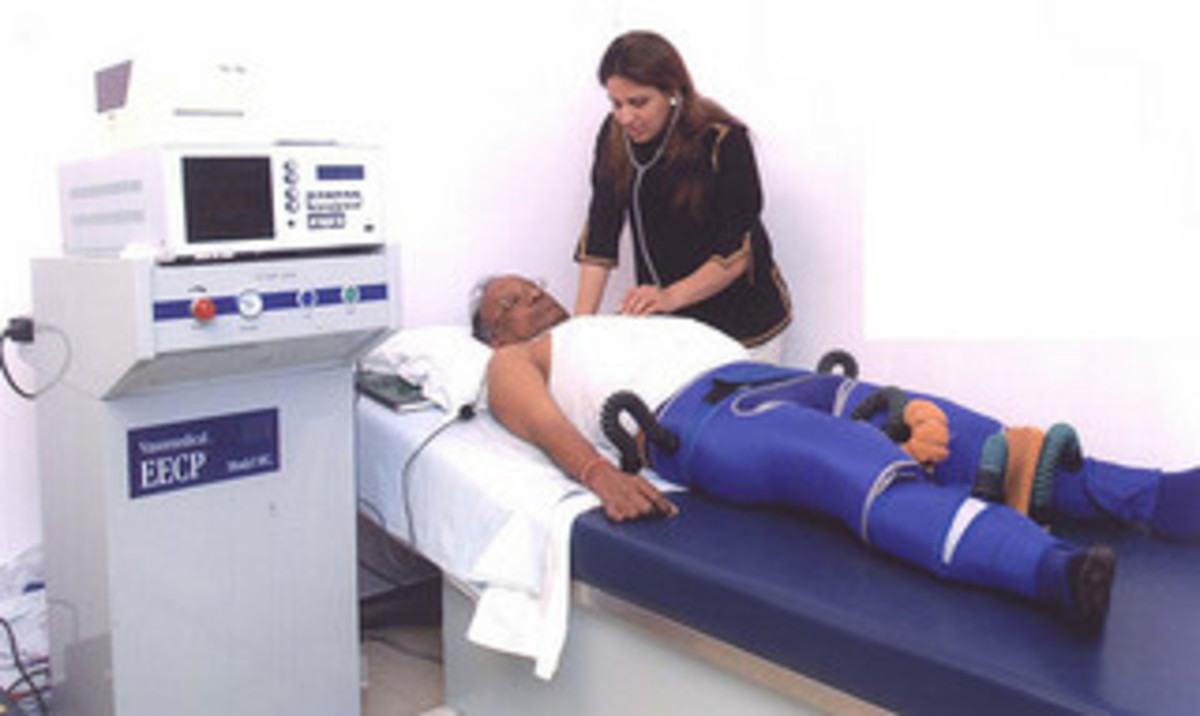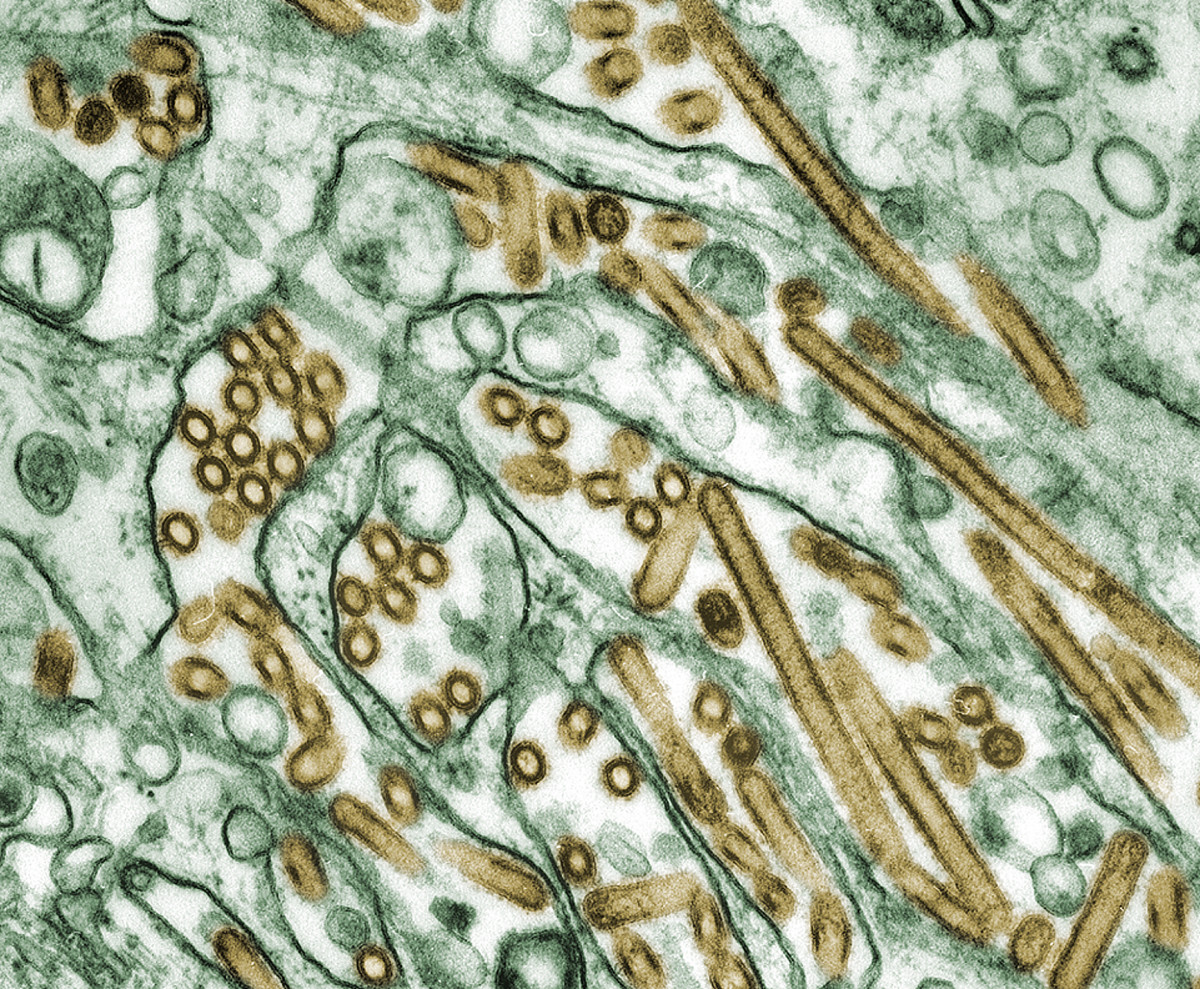Managed Care May Expose You to Higher Risks In Heart Bypass Surgery
Bypass vein grafted on artery with plaque

Compare insurance- and managed-care chosen hospital’s past performance up to 1995 with their present performance
Rosier but still scary mortality rate
In the United States, the mortality rate of heart bypass surgery known by the general pubic is 2 percent to 5 percent. That is the average range of mortality rate. This range gives a rosier picture than that of reality.
In the 1970s up to 1995, the range of mortality rate in coronary-artery bypass graft surgery (CAB G, pronounced “cabbage”) was 1.4 percent to 10.4 percent (Anders, G. Health Against Wealth.1996). The rating of 1.4 to 1.99 percent might be rosy but very few heart surgeons or hospitals could make that grade.
George Anders reported in 1996: “Each year more than 900,000 American men and women die of cardiovascular disease, making it the leading killer for both sexes” Some 600,000 Americans went for a heart repair: valves replaced, pacemakers installed and sometimes heart transplants. The most common was CABG.
CABG started in 1964. It was promoted by President John F. Kennedy and President Lyndon Johnson. It elicited awe comparable to that of NASA’s space program. In the 1970s and 1980s heart surgery was looked upon not only as a medical priority but also as an economic bonanza.
“…Drug companies, medical-equipment makers, cardiologists, and heart surgeons all kept widening the circle of patients they treated, sometimes leading to unnecessary procedures and inflated ‘demand’ for their services. Providers also learned that their lifesaving work could fetch stunning prices, far in excess of the direct costs….” (Anders, G. Health Against Wealth. 1996:95).
For myself I want a mortality rate of 0. That means, I am certain of survival before ever going to the operating table for heart bypass surgery. I was diagnosed as a candidate for bypass surgery by a cardiologist in 2002 but did not go for it. I did not want to expose myself to the mortality rate. I have chosen to go for infusion chelation therapy which is more effective and non-invasive.
Reaction of managed-care companies
"...Get costs for heart care under control.”
First, they emphasized prevention. Second, they discouraged use of tests and surgery for people afflicted with heart disease. Third, they negotiated for rock-bottom contracts with hospitals canvassed for their fees as if “buying paper towels.”
In 1991-1993 a “low-cost producer” in heart surgery for managed care patients registered a 30-day mortality rate that peaked at 10.4 percent. That is, patients who went through heart bypass operation died within 30 days after the operation. This was the record of a middle-sized hospital in Los Angeles.
This hospital explained that 30 percent of its heart patients were 75 years or older and 20 percent were re-dos. These re-dos had a first bypass graft that “stopped working well,” and a second bypass operation was riskier (Anders, G. Health Against Wealth. 1996:100). Despite a high mortality rate, this hospital won several contracts from managed care.
In 1994, this hospital recorded for CABG patients a 30-day death rate of 3.6 percent; in 1995, 3.9 percent.
Data compiled by the Pennsylvania Health Care Cost Containment Council showed that the Temple University Hospital had a mortality rate of 1.4 percent in 1993; the lowest among hospitals in Philadelphia if not in the whole United States. However, it had not "been an aggressive discounter to managed-care plans." Temple was rarely used by managed-care for routine CABG but used for riskier heart cases like transplant.
Two big managed-care plans in Philadelphia picked another hospital with a CABG mortality rate of 3.6 percent in 1993 (more than double that of Temple University Hospital).
Another record low mortality rate (1.7 percent) was registered by the New York Hospital that was regarded as one of the best CABG centers in the U.S.A. One of its surgeons. Jeffrey Gold, “had the lowest mortality rate among all 220 active heart surgeons in New York State,” which means excellent performance.
Drop a good hospital for another that gives discounts
The New York Hospital was patronized by insurance companies and managed care. However, on October 1,1995, an insurance plan dropped its contract with this hospital. The insurance plan switched for a hospital located in Long Island that agreed to give a discount of $375,000 for its members. From this deal the winning hospital expected some 200 patients more per year. It would generate some $1 million for health workers and surgeons and maybe $4 million per year for the hospital.
This hospital ranked "14th best out of 31 hospitals performing open-heart surgery" with a mortality rating of 2.65 percent in 1993. Yet it was chosen over New York Hospital with a mortality rating of 1.7 percent in the same year.
The chief of cardiothoracic surgery of this winning hospital said: "When managed-care companies look at things, I think quality is an issue, but the three most important things are cost, cost, and cost" (Anders, G. Health Against Wealth.1996:93).
In September 1995, a patient who could be managed with medication rather than with a CABG implored the New York Hospital to schedule a CABG for himself immediately. The attending surgeon was surprised and asked why the rush. The patient said that he knew his managed-care plan would be getting a new contract hospital by October so he wanted a CABG now for his safety that he is still covered by a contract with the New York Hospital.
How could hospitals have stayed afloat with sizable discounts?
Surgeon’s fees were reduced to half ($5,000). Hospital fees were cut down to $18,000, then further down to 16,500. Nursing staff was reduced from one nurse for every three patients to one nurse for every ten patients. In post operation, patients were rushed rapidly from the intensive-care units (the most expensive area); patients were rushed home from the hospital, from the established 10 days stay in the hospital down to only 4 days. After-surgery tests were reduced. The 18-session intensive physical therapy after surgery was reduced to only 9 sessions "despite claims that patients' recoveries might be jeopardized." An impression was left that three sessions was preferred. A cardiac nurse said that they could not do it; it looked like it was a window dressing rehab program.
The shift from the older per-day charges to the discounted all-inclusive packages lead to quicker discharges of patients from the hospital leaving much of the care burden to families and to patients themselves. Fortunately, a medical advance in a new anesthesia agent came around; it could leave the body of the patient faster than the old one that enabled him to move around the sooner.
Cost of heart care was reduced without a corresponding improvement in mortality rate (less deaths) or elimination of complications that required hospital readmissions, a sign of bad care.
To put it in a straightforward fashion, if you switch from a good hospital to a low-fee with a poor performance hospital you come out with a low outcome,
Foot dragging on technological advances
Managed care lagged behind advances in heart care. When heart attack occurred, blood clots were traditionally dissolved with the enzyme streptokinase. A more advanced one, two percent better in performance, was developed -- the recombinant tissue plasminogen activator that costs $2,200 per dose. Managed-care patients were less likely to be given t-PA by 51 percent than patients being treated in fee-for-service setups.
The stent is seen medically as a vast improvement in angioplasty, considered as an alternative to CABG. Stent is a thin-wire prop left behind after the balloon angioplasty had been withdrawn to prevent the narrowed artery from closing up again. Some managed care companies were reluctant to pay $1,600 for the stent; others did not pay for it at all. A top cardiologist said of hesitant reimbursements of stents by insurers: "a horrific thing to do, let alone publicize."
For managed-care contracts, Janet Monroe negotiated in behalf of New York University Medical Center. In 1993, this hospital's adjusted mortality rate was 2.24 percent; in the period 1991-93, its mortality rate was significantly lower than the state of New York average. She presented this outstanding performance to entice clients to pay extra but got a cold shoulder. Her complaint: "They give lip service to quality...." (Anders, G. Health Against Wealth. 1996:104).
How do they fare with advances in heart care?
The CABG came around in 1964. An alternative mode of treatment for heart disease was developed since 1962 when Dr. Denham Harman, MD made a historic interpretation that free radicals cause degenerative diseases and aging. The EDTA (ethylene-diamine-tetra-acetate) approved by FDA for use to remedy lead poisoning has been found to work for the cardiovascular system as well. (I have Hubs "Heart Disease: The Traditional Risk Factors Versus Free Radicals as Causes" and "Free Radicals With Unpaired Electrons in Alternative Medicine").
However, infusion chelation therapy was scorned by some insurance companies and managed-care plans (Cranton, D., MD Bypassing Bypass. 2nd edition. 1995).
In 1975, Dr. Dean Ornish began his research on an alternative treatment of which he elaborated in his books (1990 and 1996 editions) "Dr. Dean Ornish Program for Reversing Heart Disease." One can say Dr. Ornish program is an alternative because he claims that heart disease (myocardial ischemia) can be reversed without the use of drugs and without surgery. In a book in which he is one of contributing authors, he said that some insurance companies are including his program for their members. In the 1996 edition of his book, Ornish wrote: "New evidence is validating the health benefits of antioxidants such as beta-carotene, vitamin E, and vitamin C, all of which are high in plant-based diet and low in meat-base diet."
CABG is based on risk factors; infusion chelation therapy is based on free radicals. Dr. Ornish's program is based on risk factors with a modification. In the 1996 edition of his book he said that vitamins can help in reversing heart disease. In fact, in both editions of his book he included maintenance and reversal diets for heart disease. Antioxidants fall under the free radical paradigm rather than under the risk factor paradigm. So, Dr. Ornish's program looks like a transition between the risk factors school and the free radical school of medicine.
In the 1997 edition of the book by the high priests of risk factors, Dr. Michael DeBakey, MD and Dr. Antonio Gotto, Jr., MD, "The New Living Heart," they conceded that heart disease can be reversed by lifestyle changes and cholesterol-lowering drugs.
How are insurance and managed-care companies faring now with advances in heart care compared with their performance up until 1995?
Stem cell therapy is a fast emerging treatment and cure for a lot of diseases, including heart disease. After all, a human being started with a single stem cell. The heart may take a longer time to tinker with because its muscles are considered irreplaceable like that of brain, and nerve. But the stem cell-like endothelium progenitor cells (EPC) repair the inside wall of arteries of the heart. Stem cell therapy recognizes free radicals as causes of disease (Bellomo, M. The Stem Cell Divide. 2006). EPCs can be harvested from the blood and inspected for free radical damage, ensuring that EPC's for use in therapy are free of free radical damage.
More likely savings in heart bypass surgery by choosing a hospital with a record performance of medium to high rate of mortality are made at the cost of the life of the helpless patient.










